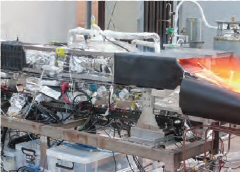Research & Development
JAXA promotes three research and development programs and a fundamental research program that underpins them.
Research on hypersonic turbojet engine
Topics
More
Combustion experiments at Mach 4 prove successful for JAXA's hypersonic turbojet
-

- Combustion experiments were performed at the Noshiro Rocket Testing Center on March 5 to evaluate the performance of JAXAs hypersonic jet at simulated Mach 4 flight conditions. As the turbojets engine uses ultra-low-temperature liquid hydrogen for its fuel source, it can cool the compressed, high-temperature air that flows into the engine during hypersonic flight. In front of the engine is a heat exchanger with an array of thin metallic tubes through which the liquid hydrogen flows, cooling the air. The heat exchanger also restricts temperature increases inside the engine, which makes the engine operable at up to Mach 5. Driven by the aim of one day making its hypersonic turbojets part of hypersonic passenger aircraft, JAXA has already developed an engine for technological verification purposes and used it to conduct static firing experiments under takeoff conditions and flight experiments at Mach 2. With the successful results of the recent combustion experiments at Mach 4, JAXA has now established the world's fastest turbojet technology.
March 6, 2013